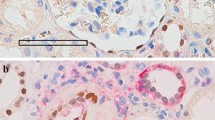Abstract
Background
The search for risk factors for chronic kidney disease in children with focal segmental glomerulosclerosis (FSGS) is important in defining prognosis and individualized treatment. This study preliminarily investigated whether CD44 immunostaining in glomerular parietal epithelial cells (PECs) is a prognostic marker in pediatric FSGS.
Methods
In this retrospective study, 26 patients with FSGS, biopsied from 1985 to 2010, were evaluated. Immunohistochemistry for CD44 was performed in all cases. For analysis purposes, patients were grouped according to whether or not they were positive for CD44 in PECs. The primary outcome was a decline in baseline estimated glomerular filtration rate (eGFR) of 50% or more.
Results
Median follow-up was 6.9 years. Median renal survival was 14.5 years and probability of a 50% decline of eGRF was 30% in 10 years. Nine children exhibited the primary outcome and 7 developed end-stage renal disease (ESRD). In comparison with PEC CD44-negative patients (n = 18), PEC CD44-positive patients (n = 8) presented lower baseline eGFR (99 ± 41 versus 141 ± 44 ml/min/1.73 m2, p = 0.035) and a significant decline in eGFR (−38.6 ± 39.5 versus −5.6 ± 25.3 ml/min/1.73 m2/year, p = 0.018). No difference was observed in FSGS subtypes or other glomerular features. Presence of CD44 staining in PECs was significantly associated with the decline in baseline eGFR of 50% or more. Renal survival was significantly reduced in PEC CD44-positive patients (3.8 vs 14.6 years in C4d-negative, p < 0.05).
Conclusion
Our preliminary findings indicate, for the first time, that positivity for CD44 in PECs seems to be a pathological marker of renal function deterioration in pediatric patients with FSGS.

Similar content being viewed by others
References
D’Agati VD, Kaskel FJ, Falk RJ (2011) Focal segmental glomerulosclerosis. N Engl J Med 365:2398–2411
Kitiyakara C, Kopp JB, Eggers P (2003) Trends in the epidemiology of focal segmental glomerulosclerosis. Semin Nephrol 23:172–182
Lim BJ, Yang JW, Do WS, Fogo AB (2016) Pathogenesis of focal segmental glomerulosclerosis. J Pathol Transl Med 50:405–410
Staples AO, Greenbaum LA, Smith JM, Gipson DS, Filler G, Warady BA, Martz K, Wong CS (2010) Association between clinical risk factors and progression of chronic kidney disease in children. Clin J Am Soc Nephrol 5:2172–2179
Mendonça AC, Oliveira EA, Fróes BP, Faria LD, Pinto JS, Nogueira MM, Lima GO, Resende PI, Assis NS, Simões E, Silva AC, Pinheiro SV (2015) A predictive model of progressive chronic kidney disease in idiopathic nephrotic syndrome. Pediatr Nephrol 30:2011–2020
National High Blood Pressure Education Program Working Group on High Blood Pressure in Children and Adolescents (2004) Fourth report on the diagnosis, evaluation, and treatment of high blood pressure in children and adolescents. Pediatrics 114:555–576
International Study of Kidney Disease in Children (1981) The primary nephrotic syndrome in children: identification of patients with minimal change nephrotic syndrome from initial response to prednisone—a report of the International Study of Kidney Disease in Children. J Pediatr 98:561–564
D’Agati VD, Fogo AB, Brujin JA, Charles Jennete J (2004) Pathologic classification of focal segmental glomerulosclerosis: a working proposal. Am J Kidney Dis 43:368–382
Taal MW, Brenner BM (2006) Predicting initiation and progression of chronic kidney disease: developing renal risk scores. Kidney Int 70:1694–1705
Appel D, Kershaw DB, Smeets B, Yuan G, Fuss A, Frye B, Elger M, Kriz W, Floege J, Moeller MJ (2009) Recruitment of podocytes from glomerular parietal epithelial cells. J Am Soc Nephrol 20:333–343
Lasagni L, Romagnani P (2010) Glomerular epithelial stem cells: the good, the bad, and the ugly. J Am Soc Nephrol 21:1612–1619
Smeets B, Kuppe C, Sicking EM, Fuss A, Jirak P, van Kuppevelt TH, Endlich K, Wetzels JF, Gröne HJ, Floege J, Moeller MJ (2011) Parietal epithelial cells participate in the formation of sclerotic lesions in focal segmental glomerulosclerosis. J Am Soc Nephrol 22:1262–1274
Smeets B, Stucker F, Wetzels J, Brocheriou I, Ronco P, Gröne HJ, D’Agati V, Fogo AB, van Kuppevelt TH, Fischer HP, Boor P, Floege J, Ostendorf T, Moeller MJ (2014) Detection of activated parietal epithelial cells on the glomerular tuft distinguishes early focal segmental glomerulosclerosis from minimal change disease. Am J Pathol 184:3239–3248
Fatima H, Moeller MJ, Smeets B, Yang HC, D’Agati VD, Alpers CE, Fogo AB (2012) Parietal epithelial cell activation marker in early recurrence of FSGS in the transplant. Clin J Am Soc Nephrol 7:1852–1858
Hodgkins KS, Schnaper HW (2012) Tubulointerstitial injury and the progression of chronic kidney disease. Pediatr Nephrol 27:901–909
Acknowledgements
The authors dedicate this work to the deceased Professor José Silvério Santos Diniz, founder of the Pediatric Nephrology Unit, Clinics Hospital, Federal University of Minas Gerais, Brazil. The authors thank Dr Luiz Sérgio Bahia Cardoso and all other colleagues who processed medical records, managed patients, performed renal biopsies, and assisted with follow-up.
Author information
Authors and Affiliations
Corresponding author
Ethics declarations
The ethics committee of our institution approved the study under the protocol CAAE03203413.0.0000.5149.
Financial support
FAPEMIG (Fundação de Amparo à Pesquisa do Estado de Minas Gerais, Brazil), CNPq (Conselho Nacional de Desenvolvimento Científico e Tecnológico, Brazil), and CAPES (Coordenação de Aperfeiçoamento de Pessoal de Nível Superior).
Conflicts of interest
The authors have no conflicts to declare.
Electronic supplementary material
Supplementary Table 1
(DOCX 24.6 kb)
Rights and permissions
About this article
Cite this article
Froes, B.P., de Almeida Araújo, S., Bambirra, E.A. et al. Is CD44 in glomerular parietal epithelial cells a pathological marker of renal function deterioration in primary focal segmental glomerulosclerosis?. Pediatr Nephrol 32, 2165–2169 (2017). https://doi.org/10.1007/s00467-017-3775-4
Received:
Revised:
Accepted:
Published:
Issue Date:
DOI: https://doi.org/10.1007/s00467-017-3775-4




